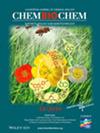Peptide Stapling Using Sonogashira Coupling.
IF 2.6
4区 生物学
Q3 BIOCHEMISTRY & MOLECULAR BIOLOGY
引用次数: 0
Abstract
An efficient method for the stapling of peptides by linking residues at the i and i+4 or i and i+7 positions through Sonagashira coupling is reported. The alkyne and aryl iodide functionality required are introduced by modifying tyrosine residues to 4-iodophenylalanine (PhI) and 4-propargyloxyphenylalanine (TyP) residues. Comparing the conformations of a stapled peptide with the corresponding linear peptide using CD spectroscopy reveals a more helical structure for the stapled peptide.
求助全文
约1分钟内获得全文
求助全文
来源期刊

ChemBioChem
生物-生化与分子生物学
CiteScore
6.10
自引率
3.10%
发文量
407
审稿时长
1 months
期刊介绍:
ChemBioChem (Impact Factor 2018: 2.641) publishes important breakthroughs across all areas at the interface of chemistry and biology, including the fields of chemical biology, bioorganic chemistry, bioinorganic chemistry, synthetic biology, biocatalysis, bionanotechnology, and biomaterials. It is published on behalf of Chemistry Europe, an association of 16 European chemical societies, and supported by the Asian Chemical Editorial Society (ACES).
 求助内容:
求助内容: 应助结果提醒方式:
应助结果提醒方式:


